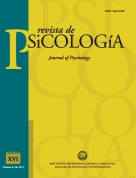Please use this identifier to cite or link to this item:
https://repositorio.uca.edu.ar/handle/123456789/5970| Título: | Evaluación perceptivo auditiva de voces degradas y su correlación con medidas acústicas | Autor: | Elisei, Natalia Gabriela Evin, Diego Alexis |
Palabras clave: | ACUSTICA; MEDICIONES; ESCALA GRBAS; TRASTORNOS DE LA VOZ; FONOAUDIOLOGIA | Fecha de publicación: | 2012 | Editorial: | Universidad Católica Argentina. Facultad de Psicología y Psicopedagogía. Departamento de Psicología EDUCA |
Cita: | Elisei, N. G., Evin, D. A. Evaluación perceptivo auditiva de voces degradas y su correlación con medidas acústicas [en línea], Revista de Psicología. 2012, 8(16). Disponible en: https://repositorio.uca.edu.ar/handle/123456789/5970 | Resumen: | Resumen: El objetivo es determinar utilizando las mediciones acústicas, qué información es más relevante para el oyente al momento de categorizar el grado general de disfonía. Se eligieron 8 (4 voces femeninas y 4 voces masculinas. Cada emisión fue evaluada auditivo perceptualmente a través del item G de la escala GRBAS por 10 oyentes experimentados y acústicamente mediante medidas de aperiodicidad, ruido y caos. El estudio estadístico de análisis discriminante señala la importancia de GNE, Jit y Jitter_cc y Lyapunov como parámetros predictores del grado general de disfonía. La aplicación del método k-means evidencia que existen rasgos en los parámetros acústicos empleados que permiten agrupar objetivamente las voces estudiadas con 100% de precisión para la clase 0, 96% a la clase 2 y 79% a la clase 3. Un mayor número y variabilidad de casos se necesita a fin de verificar los resultados preliminares. Abstract: The goal is to determine using acoustic measurements, which information is the most relevant to listeners at the time of categorizing the overall degree of dysphonia. Eight voice signals were chosen (4 female voices and 4 male voices). Each voice was perceptually evaluated through the item G of GRBAS scale by 10 experienced listeners and acoustically by aperiodicity, noise and chaos measures. The statistical study by discriminant analysis shows the importance of GNE, Jit and Lyapunov Jitter_cc as parameters and predictors of overall degree of dysphonia. The application of the k-means evidence there are features in the acoustic parameters that allow us to objectively group the voices studied with 100% accuracy for class 0,96% for class 2 and 79% for class 3. A greater number and variability of cases are need to verify those preliminary results. |
URI: | https://repositorio.uca.edu.ar/handle/123456789/5970 | ISSN: | 1669-2438 | Disciplina: | PSICOLOGIA | Derechos: | Acceso Abierto | Fuente: | Revista de Psicología Vol. 8, No.16, 2012 |
| Appears in Collections: | RdP - 2012 Vol. 8 nro. 16 |
Files in This Item:
| File | Description | Size | Format | |
|---|---|---|---|---|
| evaluacion-perceptivo-auditiva-voces-degradas.pdf | 461,17 kB | Adobe PDF |  View/Open |
Page view(s)
343
checked on Apr 30, 2024
Download(s)
207
checked on Apr 30, 2024
Google ScholarTM
Check
This item is licensed under a Creative Commons License

